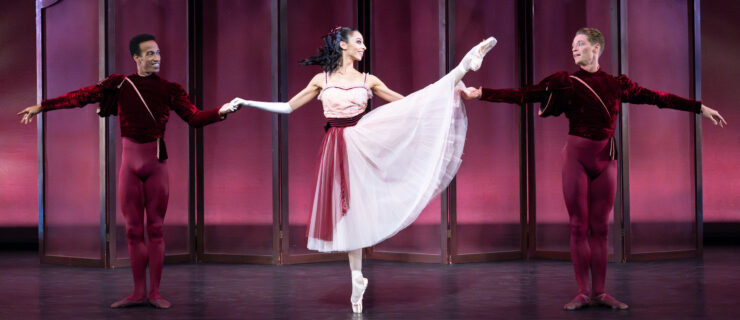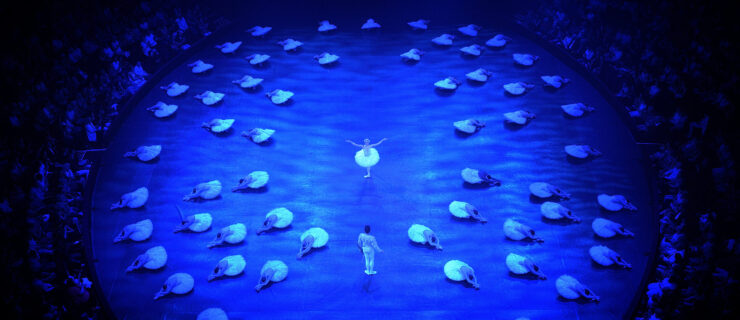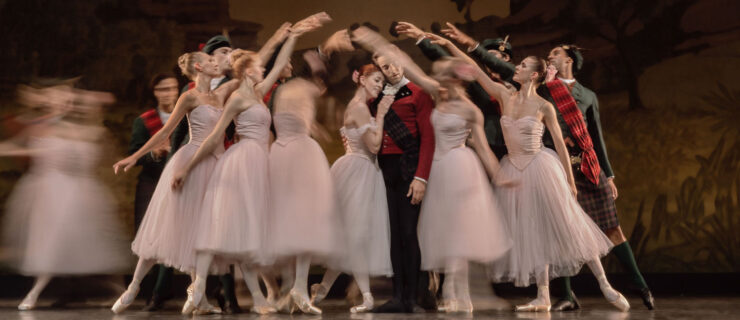Your Training: Can You Learn Stage Presence?
To watch Irina Kolpakova coach Swan Lake is to witness a true artist at work. Although long retired from the stage, the American Ballet Theatre ballet mistress still possesses a commanding presence and an instinctive artistic spirit.
“Don’t think about your shape when you first see Siegfried,” she tells soloist Isabella Boylston during rehearsal for Odette’s Act II entrance. “This is not ‘port de bras.’ This is ‘Don’t touch me!’ ” Kolpakova demonstrates, transforming instantly into the Swan Queen. Her eyes sparkling and alive, every inch of her diminutive stature swells with a palpable energy capable of reaching the highest ring of the balcony.
Call it stage presence, call it the “it” factor, some dancers just have a natural ability to draw people in and change the atmosphere around them. Stage presence can carry a dancer to a higher artistic realm. It’s the final piece of the puzzle, the emotional heart of a performance that can bring an audience to tears. Without it, even the best choreography risks falling flat.
But what is stage presence, exactly? “It’s doesn’t necessarily have anything to do with acting,” says former ABT principal Alessandra Ferri, herself famous for emotionally captivating performances. While technique and strong acting skills are essential components, stage presence goes beyond. “It’s what people call ‘charisma.’ It’s being in charge of the space around you and in tune with the energy of the audience.”
Ferri cites Rudolf Nureyev as the ultimate example: “You could not not look at him. Even when he was standing still, he galvanized your attention.” But while some dancers exude natural magnetism onstage, others struggle to capture it, giving technically brilliant but emotionally vacant performances. With stage presence seemingly so instinctive, is it possible to learn?
“I think presence stems from a seed that you either have or don’t have,” says Ferri. “It can’t be taught completely. But, you can help people who don’t have it improve.”
Darla Hoover, associate artistic director of Ballet Academy East’s pre-professional division (New York City Ballet’s charismatic soloist Chase Finlay is a former student) agrees to a point. “There are some special dancers where it’s innate—you can just see it, even at 6 years old. But I also think it can be learned, because you’re speaking about something within that comes out. And we all have those things within. When it’s cultivated and nurtured, stage presence can grow.”
There are a number of reasons why certain dancers lack presence. Some might be self-conscious about their dancing, or feel embarrassed showing emotion. Others simply over-prioritize technique. Hoover notes that sometimes shy dancers need the stage to really blossom. “They feel safer onstage than they do in rehearsal because the studio is so intimate.”
When students are struggling, Hoover uses music to coax them out of their shells. It helps them link feelings to movement quality. “Everyone has life experiences that are emotional,” she says. “I’ll ask them, ‘How does this music make you feel? What happened in your life that fits that feeling?’ ” As students practice associating music with their own experiences, they gradually learn to tap emotions without having to think of a specific event. She admits that the process takes time and conscious effort. “But then you’ll see that something’s changed in them,” she says. “They still might not have as much presence as the dancer who has it naturally, but you can tell that change has happened.”
Kolpakova often tells dancers to think of an inner dialogue to help them connect with a character. Back in rehearsal, she reminds Boylston that her movements must reflect Odette’s fear of Prince Siegfried. When Boylston tries again, her movement is noticeably more alive and expressive.
Sometimes dancers aren’t aware of how full their movements need to be to register onstage. “My teachers would say to me, ‘Irina, it’s not enough,’ ” Kolpakova recalls. “It has to be bigger so the audience sees you and understands.” In rehearsals, she reiterates her teacher’s advice during a mime scene between Odette and Siegfried. “More,” she says, encouraging Boylston not to be too tentative. She demonstrates, gesturing first to her heart, then opening her palms and lifting up through her body. “You’re saying this is me. Me. Stretch up, up with your chin.” Boylston listens and repeats the sequence, this time making a larger, more readable statement.
Of course, coaching can only take dancers so far. It’s up to the artist to push herself beyond her comfort zone—and that takes the courage to let go onstage as well as a willingness to practice. If necessary, experiment in front of the mirror at home for a while to help develop confidence. Remember, too, that the studio is a safe haven for mistakes.
Observing other artists can help. San Francisco Ballet principal Yuan Yuan Tan, who projects a serene, ethereal quality onstage, always found Natalia Makarova’s presence particularly mesmerizing. As a young student, Tan studied videos of Makarova in Swan Lake, Giselle and Romeo and Juliet for inspiration.
But while outside sources can help improve stage presence, growth must ultimately come from within. Dancers must be willing to open up and shed their inhibitions—no one can do that for them. “We dancers can be stubborn and just do things the way we always do,” says Tan. “But to be better than ourselves, we have to be willing to change.”
Ballet Boot Camp
If you’re starting a new apprenticeship or trainee position next season, you’ll want to be at the top of your game come September. Don’t let the end of summer go to waste. Maryland Youth Ballet’s August Ballet Boot Camp is designed to zero in on your technique. On top of conventional classes like pas de deux and pointe, dancers take classes focused specifically on pirouettes, petit allégro and port de bras. They also build their strength through floor barre and conditioning. Two one-week sessions run from August 5–16 for $450 a week. Advanced dancers ages 15 to 25 can audition in-person during one of MYB’s year-round classes or by DVD or online video. See marylandyouthballet.org.
Technique Tip
“We are not robots. You have to constantly work to improve or else you’ll fall back on bad habits. For every combination in class, I think, ‘How would I do this onstage?’ Maybe I will really present my heel in this développé and elongate my neck like a swan. I play little games with myself. Each movement can tell a story.” —Abigail Mentzer, Pennsylvania Ballet
Get Edgy
Although it?’s not well-known in the U.S., Vancouver?’s Arts Umbrella conservatory is a contemporary ballet powerhouse in Canada. Alumni regularly go on to perform in top companies, such as Dresden Semperoper Ballet and Cedar Lake Contemporary Ballet. The school has a particularly close connection with Emily Molnar?’s Ballet BC, where about half of the dancers are Arts Umbrella alumni. Molnar formerly served as Arts Umbrella?’s artist-in-residence, and she now mentors the advanced students during the school?’s summer Dance Intensive (which runs August 5–23 this year). Students get an inside look at her company—?plus a prime networking opportunity—?while collaborating directly with Molnar and Ballet BC dancers on a piece for a final performance. In addition, all levels take classes with instructors from Les Ballets Jazz de Montréal and Compañía Nacional de Danza, among others. Audition in person on April 7 or send a DVD. See artsumbrella.com.
Your Class Playlist
Need to give yourself a barre? Create a playlist of ballet classics on your iPad or iPhone with the app Ballet Class from balletto.net. It’s not quite as personalized as a live accompanist, but it’s close to the next best thing. You can control how many bars you’d like each song to play and manually alter the speed of each combination until you get the tempo you want. The full version ($9.99) comes with 52 songs that you can preset into a playlist—or you can try the Lite version of the app, which offers 12 basic tunes for free.





